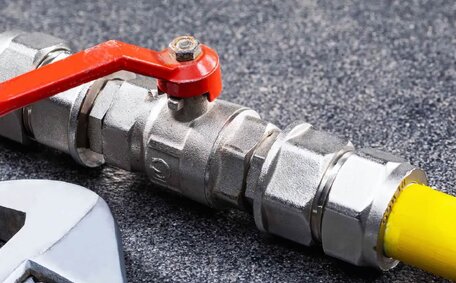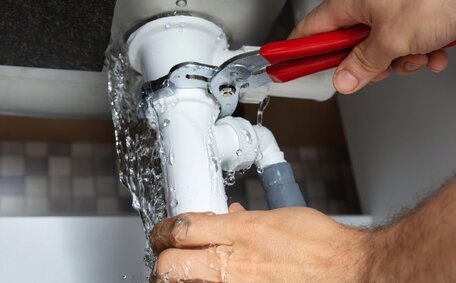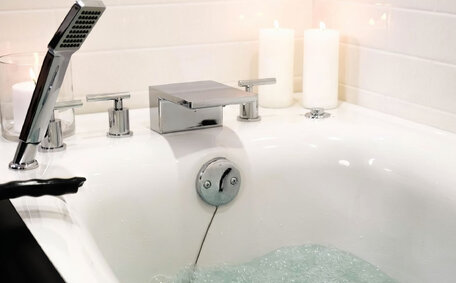Locating Your Gas Meter
You’ll usually find your gas meter outside your house, often at the front or side. It’s housed in a grey metal box near ground level, making the valve easily accessible. If you have trouble, follow the gas line entering your property to locate your meter box.
Common places to check include:
- Near the front sidewalk or driveway
- On the side of the house behind shrubbery or bushes
- Under or near windows on the first floor
- By the air conditioning unit
If your home uses a gas cylinder instead of utility-supplied natural gas, the tank is typically visible in the yard with an accessible shutoff valve. Trace these gas pipes to identify the shutoff valve’s location.
Finding your gas metre or LP tank’s location is crucial before an emergency unfolds. Knowing this helps you quickly shut off the gas for safety.
Identifying the Gas Shutoff Valve
To manually halt your home’s gas, use the gas shutoff valve or emergency control valve (ECV), situated between the meter connections. It’s a lever or handle connected to the main supply pipe that brings gas into your residence.
The valve is typically situated on the gas meter or the pipe close to the entry point into the building. It may be on an exterior wall or underneath near the foundation.
To halt the gas flow, just rotate the ECV handle or tap 90 degrees to lie across the pipe. This stops the flow of gas. Verify that the valve is turned a full 90 degrees to ensure it’s completely closed and in the off position.
If you have liquid propane, the shutoff should be located on top of the tank where the pipe joins the cylinder that controls your gas supply. With an adjustable wrench, rotate the valve tap, which is at the cylinder’s top, clockwise a quarter turn until it’s at a right angle to the pipe.
Always make sure the ECV is clearly identified and labelled, enabling you to quickly terminate the gas supply in an emergency. It’s advisable to practice this annually, ensuring you’re adept at operating the valve when urgent situations arise.
Safety Precautions Before Turning Off Gas
It’s essential to take safety measures before turning off your home or building’s gas.
Start by putting out all open flames and turning off appliances and pilot lights before turning off the gas. This covers the furnace, water heater, stove/oven, and any gas fireplaces that are connected to your home’s gas supply. Ensure there’s absolutely there no ignition sources present that could cause an explosion risk.
Unlatch all doors and windows to facilitate the exit of gas fumes and also switch off any water pipe sources that could contribute to moisture build-up. This will help dissipate any residual gas that may be leaking.
Evacuate all individuals from the premises until after the gas has been securely turned back on and you can relight your appliances professionally.
Call emergency services and your provider before you need turn off gas and restore service if you suspect a major leak. Never turn the gas back on yourself after such an event.
Taking these basic precautions helps you avoid the dangers of gas buildup when turning off gas at the supply valve.
Step-by-Step Process for Turning Off Gas Supply
Follow these safety steps when you turn off your gas supply:
- Locate your meter outside your home. It will be in a metal box near the ground.
- Identify the appliance shutoff valve, usually a pipe attached to the gas metre. Look for a valve handle that runs perpendicular across the pipe.
- Switch off all gas appliances and extinguish gas appliances pilot lights inside the house. Ensure no ignition sources are present while you’re shutting off the gas.
- Open all doors and windows to ventilate.
- Use an adjustable wrench to give the shutoff valve a full 90 degree turn so the handle crosses over the pipe. This turns off the gas.
- Notify your gas company of the shutoff and arrange for a technician to turn your system back on and relight your appliances.
- Don’t turn the gas back on yourself. Get a certified gas technician to restore service once any repairs or maintenance is complete.
Following these steps, as endorsed by the Department of Energy, ensures a secure method to turn your home’s gas supply off during emergencies or for upkeep.
Turning Gas Back On and Relighting Pilot Lights
Reactivating the flow and reigniting appliances after disabling your home’s gas requires caution and a licenced professional. Here is an overview of the process:
- Contact your LPG provider or gas utility company to let them know you’re ready to resume service. They may need to come inspect or turn the valve back on.
- Make sure all gas appliances your home contains are turned off before the gas is turned back on. Pilot lights should remain extinguished at this point.
- Slowly turn the shutoff valve back on. Start by opening it slightly, and learn how to fully operate the valve with a decisive 90-degree turn to align with the pipe, thereby commencing meter operation. This action prompts more than just the resumption of gas; it ensures an even and safe flow back into the gas lines.
- Move from one space to another, igniting each pilot light on appliances following the guidance provided by the manufacturer. This includes the furnace, your hot water system, stove/oven, etc.
- Watch the pilot flames closely to ensure they stay lit. Also smell for gas leaks near appliances and pipe connections.
- If pilot lights repeatedly go out or you smell gas, call for professional assistance. There could be trapped air or another issue requiring attention before appliances can be safely used.
Never attempt to turn gas back on or relight appliances if you suspect a leak or are unable to get pilots lit. Call a registered gas professional who can help restore your gas service to full working order.
When to Call a Professional
There are certain situations that warrant contacting a licenced gas fitter for assistance with your gas systems and appliances:
Gas Leaks
If you smell gas or suspect any kind of leak, immediately call a professional gas technician. They can inspect your system and perform thorough leak detection to pinpoint the issue and make necessary repairs.
Pilot Lights Won’t Stay Lit
If the pilot lights won’t stay lit after resuming gas to your home, this typically signifies trapped air or another underlying issue. Professionals have the tools and expertise to properly purge the lines.
Major Emergency Shutoff
After a gas emergency shutoff, always contact your gas utility company before attempting to resume service. They will ensure safety precautions are taken when turning it back on.
Restoring Entire Gas Systems
The process of relighting various gas appliances and verifying the safety of the entire building’s gas system is quite intricate. Licenced technicians have the knowledge to check for issues and seamlessly transition the system back into operation.
Gas Safety Tips
Practising gas safety in your home is vital for preventing leaks, explosions, and carbon monoxide poisoning. Here are some tips:
- Annually inspect your gas devices to guard against wear and potential leaks.
- Familiarise yourself with the location of gas shutoff valves and know where your gas metres are. Make sure they are clearly labelled and accessible.
- Install gas detectors and carbon monoxide alarms for better safety.
- In case of a suspected leak or an appliance fault, evacuate promptly and contact the gas company or emergency services.
- Leave gas system repairs and modifications to qualified professionals. Improper work can compromise safety.
Following basic gas safety protocols in your home provides peace of mind and reduces risks associated with this common utility. Reach out to learn more about professional assistance maintaining your gas systems.
Emergency Protocols for Gas Leaks
If you smell gas or suspect a leak, immediate action is crucial. Here are the steps to take:
- Evacuate everyone from the building and surrounding area. Get to a safe location upwind of the gas source.
- When exiting an indoor leak, open doors and windows to aid ventilation.
- Call 000 for emergency services if the leak poses an explosion risk. Also contact your gas utility company to report the incident.
- Wait for emergency crews and professionals to give the all-clear before turning the gas back on or reentering the building. Gas can accumulate unseen.
- Get licensed gas fitters to inspect all gas appliances before using them again. Damaged lines or connections require repair.
Following these safety protocols during a gas leak can prevent fires, explosions, and carbon monoxide poisoning. Know what to do and act fast – lives depend on it. Feel free to contact us for expert help in safely restoring your gas systems after an emergency.






